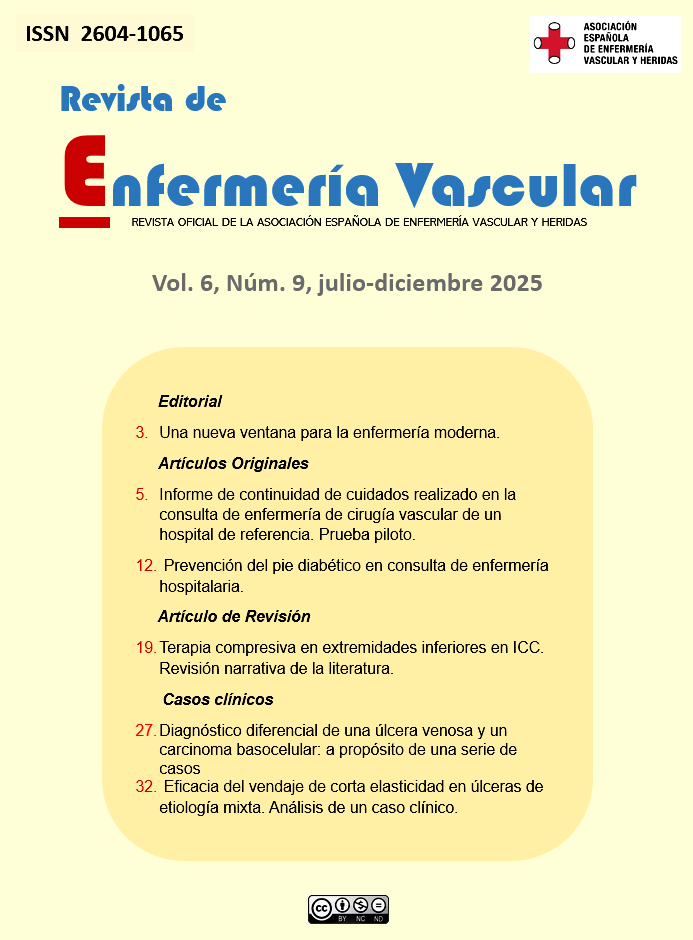Abstract
Chronic ulcers in the lower extremities pose a significant clinical challenge, with venous ulcers being the most prevalent. However, differential diagnosis with other etiologies—arterial, neuropathic, mixed, vasculitic, or neoplastic—is essential. Among the latter, malignant ulcers are uncommon but clinically relevant, especially in lesions with a slow progression.
We present three cases of women, approximately 80 years of age, with chronic ulcers in the lower extremities, initially diagnosed as venous. All shared clinical features suggestive of venous insufficiency and had received unsuccessful compression therapy. Due to the lack of therapeutic response, biopsies were performed, which revealed a diagnosis of basal cell carcinoma in all three cases.
The appearance of basal cell carcinomas in venous ulcers is rare, with squamous cell carcinoma being the most frequently described type of ulcer in these cases. The clinical course of the lesions, the histology, and the evidence reviewed suggest two possible mechanisms: secondary malignancy due to chronic inflammation or primary basal cell carcinoma with ulcerated presentation. The evidence supports the need to suspect malignancy in chronic lesions with irregular borders, purplish coloration, or friable tissue. Early biopsy is crucial to avoid diagnostic delays and optimize treatment.
Venous ulcers with a slow progression that do not respond to conventional treatment should be re-evaluated by biopsy, especially if they present atypical signs. Although basal cell carcinoma is rare, early detection allows for effective treatment, reducing complications. Continuous clinical surveillance and a rigorous diagnostic approach are essential to improve the prognosis in these patients.
References
Berenguer Pérez M, Tizón Bouza E, Soldevila Paredes MC. Diagnóstico diferencial de úlceras en extremidades inferiores. Semergen. 2021;47(8):526–35.
Combemale P, et al. Malignant transformation of chronic leg ulcers: a retrospective study of 85 cases. J Eur Acad Dermatol Venereol. 2007;21(7):935 941.
Dahle DM, Isseroff RR. Ulcerated basal cell carcinomas masquerading as venous leg ulcers: case series. Adv Skin Wound Care. 2018;31(3):124 128.
Falanga V, Medsger TA Jr, Reichlin M, et al. Dermatologic manifestations of systemic sclerosis (scleroderma). Arch Dermatol. 1986;122(5):514–20.
Frances C. Skin ulcers and vasculitis. Clin Exp Rheumatol. 2000;18(4 Suppl 20):S19–23.
García Moreno R. Úlcera de Marjolin como complicación de una úlcera venosa de larga evolución. Rev Enferm Vasc. 2023;5(8):28 32.
Grey JE, Harding KG, Enoch S. Venous and arterial leg ulcers. BMJ. 2006; 332 (7537):347–50.
Hinchliffe RJ, Valk GD, Apelqvist J, et al. A systematic review of the effectiveness of interventions to enhance the healing of chronic ulcers of the foot in diabetes. Diabetes Metab Res Rev. 2008;24(Suppl 1):S119–44.
Khan K, Schafer C, Wood J. Marjolin Ulcer: A Comprehensive Review. Adv Skin Wound Care. 2020;33(12):629 634.
Kirsner RS, Vivas AC. Lower-extremity ulcers: diagnosis and management. Br J Dermatol. 2015;173(2):379–90.
Nicoara M, Bain K, et al. Malignant transformation of nonhealing ulcer—basal cell carcinoma. Ann Vasc Surg. 2020;67: 472 478.
O’Donnell TF Jr, Passman MA, Marston WA, et al. Management of venous leg ulcers: Clinical practice guidelines of the Society for Vascular Surgery® and the American Venous Forum. J Vasc Surg. 2014;60(2 Suppl):3S-59S.
Reich Schupke S, et al. Development of spinocellular carcinoma in a long lasting and therapy resistant venous ulcer – two case studies. J Dtsch Dermatol Ges. 2008;6(7):569 572.
Serra R, Gallelli L, Buffone G, Molinari V, Montemurro R, de Franciscis S. Alteration of biomarkers in patients with chronic leg ulcers. Int Wound J. 2013;10(1):100–4.
Schnirring Judge M, Belpedio D. Malignant transformation of a chronic venous stasis ulcer to basal cell carcinoma in a diabetic patient: case study and review of the pathophysiology. J Foot Ankle Surg. 2010;49(1):75 79.
Tchanque-Fossuo CN, Millsop JW, Johnson MA, Dahle SE, Isseroff RR. Ulcerated Basal Cell Carcinomas Masquerading as Venous Leg Ulcers. Adv Skin Wound Care. 2018 Mar;31(3):130-134. doi: 10.1097/01.ASW.0000530068.44631.dc.
Valencia IC, Falabella A, Kirsner RS, Eaglstein WH. Chronic venous insufficiency and venous leg ulceration. J Am Acad Dermatol. 2001;44(3):401–21.
Weller C, Evans S. Venous leg ulcer management in general practice – practice nurses and evidence-based guidelines. Aust Fam Physician. 2012;41(5):331-7.

This work is licensed under a Creative Commons Attribution-NonCommercial-NoDerivatives 4.0 International License.

